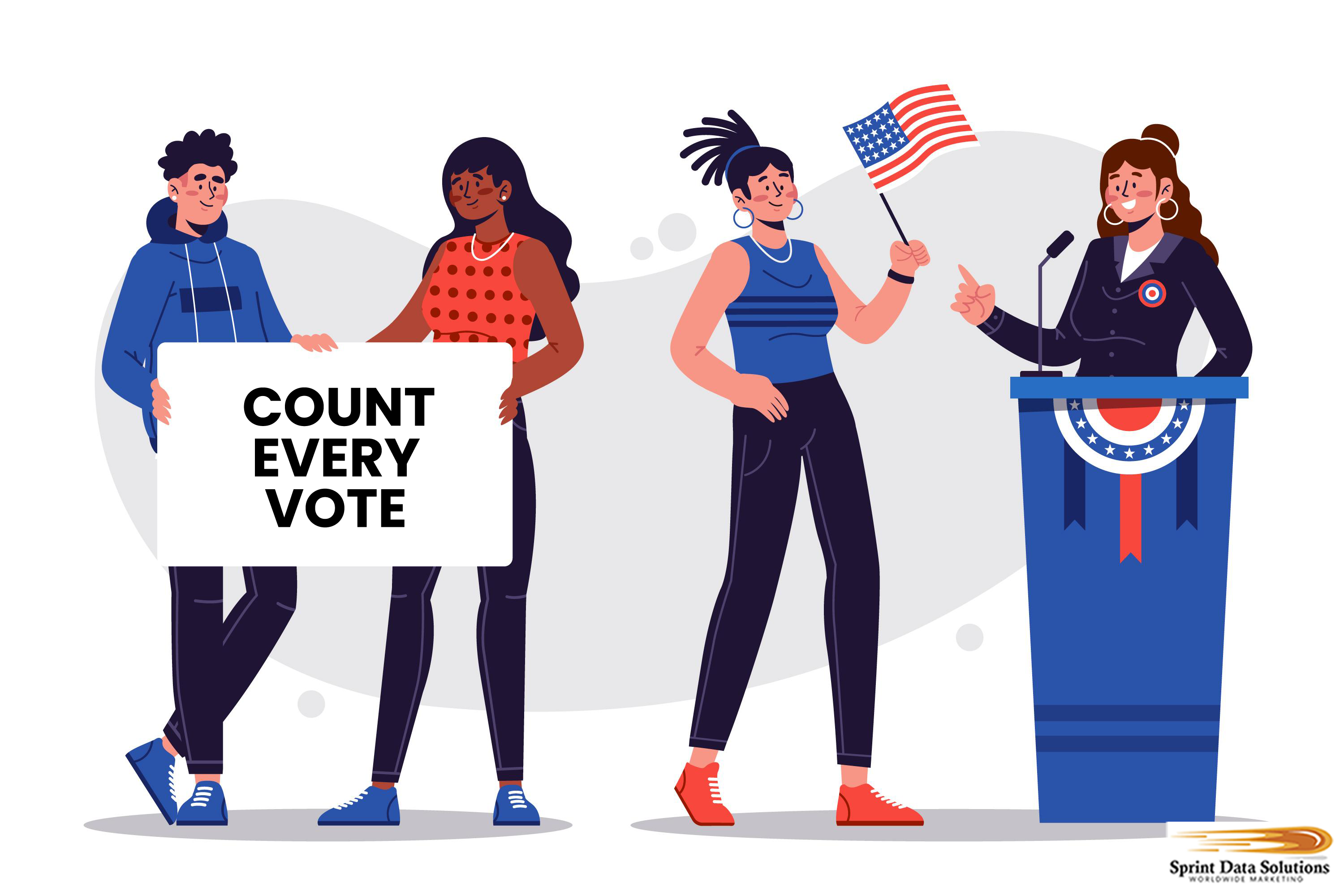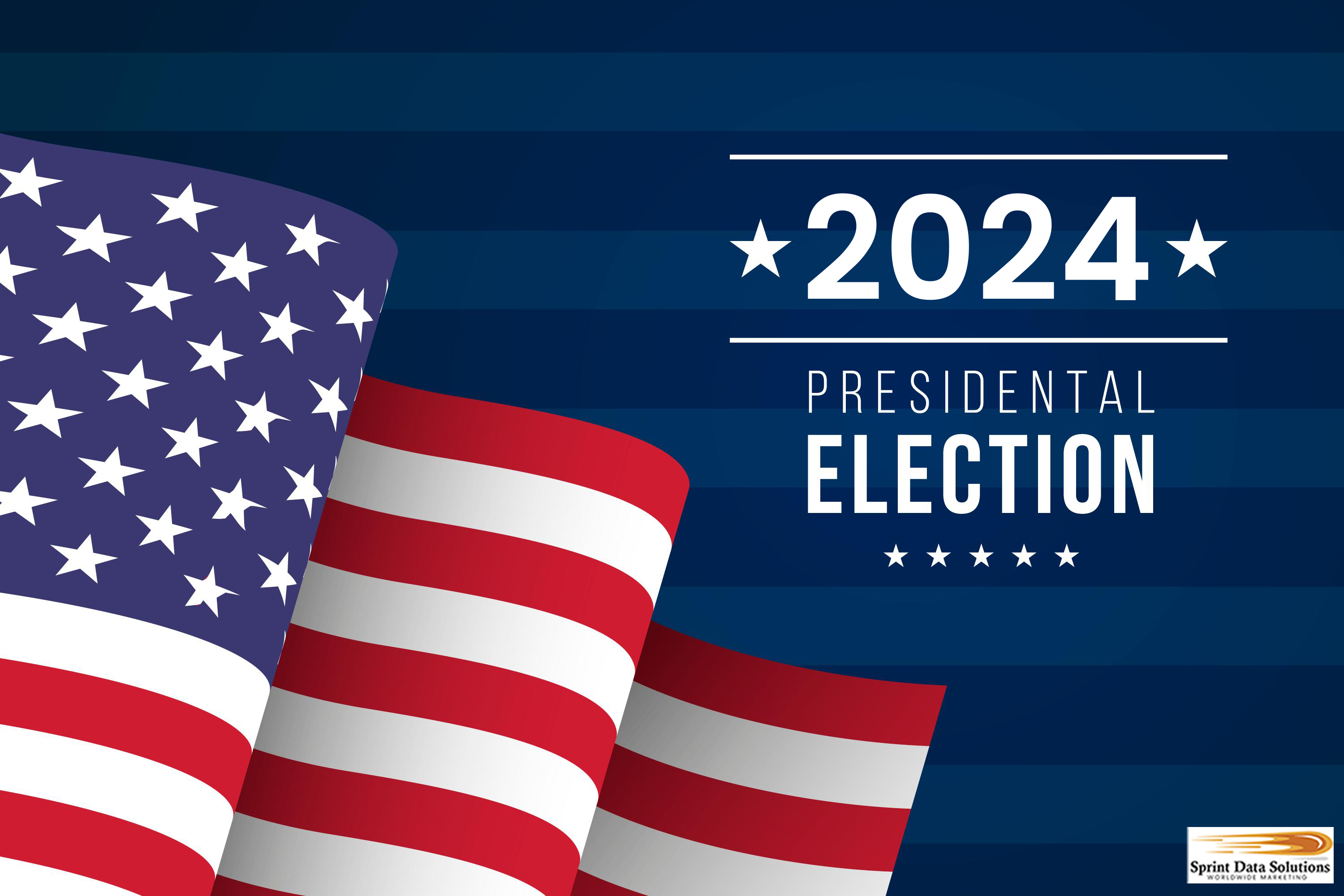Registered Voter Mailing List
The United States is one of the rare countries in the world where democracy has been a defining feature from its very foundation. Since its inception, the nation has been built on the principle that the citizens hold the power to elect their leaders. This democratic model is unique in its scope, as it empowers individuals at all levels—local, county, state, and national—to choose their representatives. From electing a city mayor to selecting the President of the United States, Americans are among the few on the planet who have consistently had a direct say in determining who will lead their communities and their country. This system ensures that the government is accountable to the people it serves, reinforcing the concept of self-governance.
Central to this democratic framework is the electoral process, a highly organized effort that facilitates the selection of public officials. The election process serves as the cornerstone of American democracy, offering an opportunity for citizens to voice their preferences through voting. Political campaigns play a crucial role in this process, working to raise awareness, educate the public, and present candidates who advocate for specific policies and solutions. Candidates often engage in debates, advertisements, and public appearances to sway voters, outlining their vision for the country or their community. These campaigns, often complex and resource-intensive, are designed to not only inform but also to inspire citizens to participate in the selection of their leaders.
On election day, voters typically gather at designated polling places to cast their ballots in person. However, recognizing the importance of accessibility and convenience, the United States has modernized its voting system to allow for absentee or mail-in voting. This expansion ensures that individuals who cannot make it to the polls due to mobility issues, work schedules, or other obstacles are still able to participate in the democratic process. By offering this alternative, the system reflects the nation’s ongoing commitment to making democracy more inclusive and equitable.
Moreover, the U.S. does not limit elections to the presidency alone. While presidential elections occur every four years, elections for local, state, and congressional offices are held regularly, meaning that the process of democracy is always active. Local elections for school boards, county commissioners, and mayors, along with state legislative races and congressional contests, are constantly shaping the political landscape. Even as the country prepares for the next presidential race, these smaller elections influence daily governance, affecting everything from local laws to the distribution of public services.
Sprint Data Solutions Worldwide Marketing has been a vital partner to political organizations for many years, providing comprehensive data and analytics to ensure that these election campaigns are successful in engaging and mobilizing voters. The company has developed expertise in understanding voter behavior, demographics, and targeted outreach strategies that help political candidates connect with potential voters. As the nation gears up for another presidential election, Sprint Data Solutions Worldwide Marketing stands ready to support the efforts of political campaigns by offering advanced data-driven solutions that enhance voter engagement and streamline the electoral process. Through strategic data collection and analytics, Sprint Data Solutions helps political entities maintain their focus on the issues that matter most to voters, ultimately ensuring that the democratic machinery continues to function smoothly and efficiently.
About Sprint Data Solutions Worldwide Marketing
Sprint Data Solutions Worldwide Marketing is the brainchild of a disabled veteran who, after years of military service, chose to channel his dedication and service to the nation into fostering economic growth. With a clear vision to transition from a life devoted to military defense to one aimed at supporting the nation’s economy, the founder set out to help businesses expand their customer base, which is central to driving economic growth. The decision was made to establish the company in Las Vegas, Nevada, where the company began as a small, local operation, but it was quickly evident that the combination of passion, hard work, and a commitment to quality would lead to something much larger.
From the outset, Sprint Data Solutions Worldwide Marketing focused on providing high-quality direct mail marketing services, and this early commitment to quality led to the gathering of extensive, valuable data on customer demographics, addresses, and other essential marketing metrics. As digital marketing emerged, the company seamlessly adapted, integrating digital marketing strategies into its offerings while maintaining its focus on direct mail marketing. This ability to pivot to meet the needs of the times allowed the company to continue its growth trajectory, and soon its reputation for quality and reliability extended far beyond Las Vegas. With a loyal customer base and a team boasting over 50 years of combined experience in marketing and promotions, Sprint Data Solutions Worldwide Marketing expanded operations across the United States, extending their reach to Alaska and Hawaii to ensure nationwide coverage.
As the company’s success continued to grow, it expanded into international markets, first servicing Canada and Mexico, and eventually reaching Europe, including France, allowing its clients to tap into global opportunities. This expansion was driven by the same dedication to service, precision, and targeted marketing that had initially fueled the company’s growth. Today, Sprint Data Solutions Worldwide Marketing offers unparalleled expertise in data management, acquisition, and analytics, with a global footprint, ensuring clients can target their ideal audience anywhere in the world while leveraging an extensive and continually updated database for the most accurate and effective marketing campaigns.

Elections Are Different In The New Millennium
The democratic process, particularly how political candidates engage with voters, has undergone significant transformation in recent years, largely driven by the advent of the Internet. With the rise of digital platforms, the way candidates campaign, communicate their messages, and mobilize support has evolved, often challenging the efficacy of older, more traditional forms of campaigning. However, the foundational goals of political campaigns have largely remained unchanged. At any level of government—local, state, or national—candidates must ultimately convince voters that they are the best candidate for the job, not just in terms of their qualifications, but also in their ability to inspire trust and enact meaningful change.
The process of persuading voters involves much more than simply advertising a candidate’s qualifications. It requires the candidate to build credibility, demonstrating both personal integrity and professional competence. The electorate needs to believe in the promises a candidate makes, and it is the candidate’s responsibility to present clear, actionable plans for the changes they hope to implement once they assume office. This may include specific policy proposals, ideas for economic reform, or a vision for improving the quality of life for constituents. The essence of campaigning remains rooted in the need to build a sense of legitimacy and capability, and this principle has held firm despite the numerous changes in the tools and methods used to convey those messages.
Historically, campaigns were more localized and personal. Before the widespread use of mass communication, the most effective way for candidates to reach voters was through face-to-face interactions. They would travel to different neighborhoods or towns, giving speeches, attending town halls, and engaging in one-on-one conversations with voters to understand their concerns and share their vision. This grassroots approach was often supplemented with printed materials like pamphlets, flyers, and posters to provide additional details on policy positions and campaign promises. While these methods were effective within their limits, the reach of a candidate’s message was inherently confined by geography and available resources.
With the introduction of radio, however, the landscape of political campaigning began to shift. Radio allowed candidates to broadcast their speeches, interviews, and policy discussions to a far wider audience than ever before, reaching people across entire regions. This new medium provided a unique opportunity to connect with voters, even those who may have been unable to attend in-person rallies or events. It also allowed campaigns to create a more polished and controlled message, as political leaders could rehearse speeches and tailor their delivery for broadcast. Political parties began to realize the power of radio as an advertising tool, and political ads started to become a key part of the electoral process, enabling candidates to reach voters with specific messages designed to persuade them.
Television brought yet another level of evolution in the way political candidates engaged with the public. As TV sets became commonplace in American homes in the mid-20th century, televised political speeches and interviews became a mainstay of campaigns. This new medium added a visual element to political discourse, allowing voters to see and hear candidates in a way that felt more personal and immediate. Candidates could now express their ideas not just through words but through body language, facial expressions, and visual imagery, adding a new layer of emotional appeal. Television also enabled debates between candidates to be broadcast nationally, offering voters a chance to compare contenders directly, in real-time, and to evaluate them on both substance and style. Political advertisements, now an established component of campaigns, were further refined to maximize their impact, using high production values and strategic messaging to capture voters’ attention.
In the modern era, the Internet has transformed political campaigning once again, leading to even more innovative and targeted methods for reaching voters. Social media platforms, websites, and email marketing have made it possible for campaigns to communicate directly with constituents on a personal level, creating highly tailored messages based on demographic data, interests, and behaviors. Digital advertising, including sponsored content, search engine marketing, and video ads, enables campaigns to target specific voter groups with precision, increasing the efficiency of outreach efforts. Additionally, the rise of data analytics and voter profiling has enabled campaigns to better understand voters’ preferences and predict how they may vote. This has led to the development of more sophisticated strategies, such as micro-targeting, where campaigns deliver individualized messages to particular segments of the electorate.
The rise of social media has also given rise to new forms of voter engagement, where candidates and political parties can directly interact with voters through platforms like Twitter, Facebook, and Instagram. These platforms allow candidates to present a more authentic, unfiltered version of themselves, while also engaging with supporters in real time. Social media has also created opportunities for grassroots mobilization, as voters can share content, organize events, and encourage their networks to get involved in the political process. This level of interactivity has allowed for more dynamic, grassroots-driven campaigns, where supporters can play a more active role in shaping the narrative and driving momentum.
In sum, while the fundamental goals of campaigning—convincing voters of a candidate’s legitimacy, qualifications, and vision—remain the same, the methods and tools used to achieve these objectives have dramatically evolved. From face-to-face interactions and printed materials to radio, television, and the digital age, political campaigns have continuously adapted to new technologies and media platforms to better connect with voters, build support, and win elections. The future of campaigning is likely to continue this trend of innovation, as new technologies and platforms emerge, further transforming the ways that candidates engage with the electorate and communicate their messages.
The advent of the Internet has revolutionized the landscape of campaigning by exponentially expanding the potential for highly targeted marketing. With the Internet’s capability to gather vast amounts of data, marketers can now construct more detailed and dynamic profiles of individuals. Every interaction, from creating accounts and joining online communities to browsing websites, generates an increasing amount of personal data. This includes not only basic demographic information but also behavioral insights, such as preferences, purchasing habits, interests, and engagement with content. As this data is collected, it can be shared across multiple platforms and organizations, resulting in a wealth of insights that marketers can use to tailor their messages with unprecedented precision.
Moreover, the Internet has completely transformed content distribution. In the past, audiences had to tune into specific radio stations or television broadcasts at scheduled times, limiting access to content. Today, however, the Internet allows for the seamless consumption of information across a multitude of platforms, at any time and from anywhere in the world, provided the individual has access to an Internet-enabled device. This shift not only empowers consumers with more control over when and how they consume content, but also presents marketers with the opportunity to deliver their messages to a wider audience in more personalized, timely, and efficient ways. The nature of distribution has evolved from passive consumption to active engagement, where individuals can access content on-demand, fundamentally changing the relationship between marketers and consumers.
Through digital platforms, the internet enables hyper-targeted advertising that draws from vast and varied data pools, allowing marketers to reach the right audience with the right message at the most opportune moment. This has led to the rise of sophisticated tools and algorithms that continually refine and optimize marketing campaigns, creating a more effective and interactive landscape. Ultimately, the Internet’s ability to capture and process data has opened the door to a new era of marketing—one that is more personalized, precise, and powerful than ever before.
Who Benefits
Sprint Worldwide Solutions Marketing offers an expansive selection of meticulously curated databases that span across a wide variety of categories, encompassing both consumers and businesses. Their contact lists are not limited to general markets but extend to more specialized sectors, including non-profit organizations, educational institutions, and governmental bodies. The company’s databases also cater to the political landscape, with detailed information on potential voters, donors, and other stakeholders. By leveraging cutting-edge analytics and data segmentation techniques, Sprint Worldwide Solutions Marketing helps clients access highly targeted lists, enabling them to effectively reach their audience—whether for consumer outreach, business networking, or political advocacy campaigns. The data provided is not only comprehensive but also continuously updated to ensure relevance, making it an invaluable tool for organizations looking to enhance their marketing and outreach efforts across a broad spectrum of industries. Some of the lists available include:
Registered Voter Mailing Lists
The strength of American democracy lies in the active participation of citizens who have registered to vote. While the specific process may vary by state, voter registration is often a prerequisite for engaging in the election process. Some states require individuals to register ahead of time, while others allow for same-day registration. Additionally, not all states mandate voters to declare their political affiliation, meaning many can remain unaffiliated or opt for a specific party. Regardless of whether a person identifies as a Democrat, Republican, or Independent, the critical factor is their decision to take the step of registering. This commitment demonstrates their willingness to engage in the political system, and it places them in a distinct position for political marketing campaigns. These individuals, having already shown an interest in the democratic process, are more likely to be receptive to political messages, making them a key audience for targeted outreach. Their registration signifies a level of civic responsibility and awareness, amplifying their potential for involvement in future political initiatives, outreach, and advocacy.
State Voters Mailing Lists
While the presidency often grabs the spotlight during elections, it’s the votes at the state level that can have the most immediate and lasting impact on individuals’ daily lives. From electing governors to choosing members of state legislatures, these elections determine the policies that shape everything from education and healthcare to taxation and infrastructure. In fact, many of the laws and regulations that people interact with every day are made at the state level.
State-level elections have a profound influence on local communities and businesses. Voters at this level help decide the leadership and legislative priorities that affect schools, roads, healthcare systems, and local economies. The decisions made by governors, state senators, and representatives directly influence the resources available to citizens, the quality of public services, and the overall economic climate within the state.
Because these elections are often more localized and less high-profile, reaching out to state voters is essential, especially during campaigns. These voters may not always be as engaged as they are in presidential elections, but educating them about what’s at stake in the state elections is crucial. Clear communication on the policies proposed by candidates, how they align with voters’ priorities, and what a particular candidate’s victory would mean for the future of the state can be pivotal in securing their support. By addressing issues that resonate with their daily lives, campaigns can ensure that state elections are given the attention they deserve and that voters are motivated to participate.
National Voter Mailing Lists
In political marketing, there are times when reaching the broadest possible audience is essential, particularly for high-stakes elections or campaigns with national implications. For larger-scale elections, such as presidential races, which require extensive outreach to a diverse electorate, national voter mailing lists become indispensable tools. These lists allow political campaigns to target millions of voters across the entire country, ensuring that critical messages, policy proposals, and candidate platforms reach a wide and varied audience. Beyond presidential elections, such outreach is also crucial for political activities tied to federal-level issues, such as national referendums or campaigns on topics that affect citizens nationwide. By using national voter mailing lists, political campaigns can efficiently address public concerns, mobilize supporters, and drive voter engagement on a massive scale, making them an essential asset for success in such large elections.

Voter Precinct Mailing Lists
Voting precinct mailing lists are essential tools for political campaigns, particularly for those focused on localized efforts. These lists provide critical insights into eligible voters within specific subdivisions of an electoral district, allowing political organizations to precisely target their outreach and communications. Whether the goal is to increase voter turnout, promote a candidate, or advocate for a policy, having access to detailed voter information on the precinct level helps shape highly effective and localized strategies.
Precinct lists break down electoral districts into manageable areas, enabling campaigns to direct their messages more accurately to voters who reside in key neighborhoods or communities. This granular data can prove invaluable, especially when resources are limited and must be allocated strategically. By knowing the specific voters in these precincts—who they are, where they live, and how they can be contacted—campaigns can tailor their efforts to the needs, concerns, and preferences of voters in those areas, increasing the likelihood of a positive outcome.
These mailing lists can also play a pivotal role in voter mobilization, helping political parties send out targeted materials such as personalized voter guides, registration reminders, and get-out-the-vote messages. In a world where voters are bombarded with generic, one-size-fits-all communications, precinct-specific lists allow campaigns to craft personalized messaging that resonates with voters on a deeper level.
For any political action that requires specific, localized knowledge of who is eligible to vote and how to contact them, precinct mailing lists are indispensable. They not only streamline campaign operations but also ensure that every effort is as efficient and effective as possible, maximizing the chances of electoral success. With data that is up-to-date and segmented by district boundaries, precinct lists offer campaigns a powerful tool for engaging voters and driving political action in a focused, impactful way.
Political Donor Mailing List
In the complex landscape of political campaigns, the importance of financial contributions cannot be overstated. Beyond the fundamental act of voting, many individuals feel an intrinsic need to support their chosen causes or candidates with more than just their time or vote. Campaigns, especially those aiming to secure high-profile government positions, require substantial funding to cover the costs of advertising, staffing, events, outreach, and more. In this regard, donations from the public become an essential element that drives campaign efforts forward.
Donors to political campaigns come from all walks of life, spanning various income brackets, demographics, and social backgrounds. Lower-income individuals often find themselves compelled to contribute despite their limited financial resources, driven by a strong belief in a candidate or a cause that aligns with their values. These donations, although modest in comparison to those from wealthier individuals, are often seen as a symbolic gesture of support, underscoring their commitment to shaping the direction of public policy.
The middle class also plays a crucial role in political financing. For these individuals, donations often reflect both a sense of civic responsibility and an investment in issues they feel directly impact their lives. Whether it’s advocating for healthcare reform, tax policy adjustments, or education initiatives, middle-class donors are typically passionate about the causes they contribute to, believing their financial support can help bring about meaningful change.
However, the most significant contributions often come from the affluent upper class. For these high-net-worth individuals, political donations are not just a gesture of civic participation, but an opportunity to support candidates and policies that align with their financial interests or ideological preferences. For many of these donors, the return on investment is more than just supporting a cause—it’s about securing favorable policies or legislation that could directly benefit their business ventures, investments, or personal interests. Whether it’s pushing for tax cuts, deregulation, or other economic policies, the contributions from the wealthiest sectors can influence the political landscape in a way that ensures their continued success and prosperity.
In the end, political donations serve as a vital lifeline for campaigns and political movements of all sizes. They allow for the grassroots support of lower-income citizens, the passionate backing of middle-class voters, and the strategic investments of wealthy donors. This multifaceted system of financial contributions helps shape the democratic process, ensuring that various voices—from the everyday citizen to the powerful elite—have a seat at the table when it comes to determining the future of the nation.
Conservative Political Donors
Political donations play a crucial role in shaping the landscape of any country’s political system, especially in the United States, where donors often align with particular parties or ideologies. In the U.S., the two primary political parties—Democratic and Republican—attract donors whose beliefs align with the values and causes supported by these parties. For conservative donors, the Republican Party serves as a focal point for their financial support. These individuals typically champion causes related to limited government intervention, fiscal responsibility, and preserving traditional values. Many conservative donors strongly support the right to bear arms, viewing the Second Amendment as essential for personal freedom. Additionally, issues like protecting Christian values, upholding religious freedoms, and supporting the role of faith in public life are central to their political engagement. Concerns about immigration policies, with a preference for stricter enforcement and border control, are also common among conservative supporters.
For political campaigns or organizations that share conservative ideals, these donors represent a valuable source of funding, especially during election cycles or periods of political activism. They are motivated by the desire to advocate for their views and influence policy decisions, supporting candidates and causes that align with their core beliefs. Conservative donors can be more than just financial backers—they can also be highly active in grassroots campaigns, mobilizing others to join their cause. This makes them an essential resource for conservative political movements, providing not only funding but also advocacy, volunteer support, and a network of like-minded individuals eager to see their political values represented in government. In turn, understanding the motivations of these donors and connecting with them on key issues is vital for any campaign or organization seeking to engage this demographic effectively.
Liberal Political Donors
Liberal causes have long played a significant role in shaping political discourse in the United States, often aligning with the Democratic Party’s values and objectives. Over the years, issues such as reproductive rights, gender and sexual equality, healthcare access, and educational reform have been key areas of advocacy for liberals. These causes have consistently attracted strong grassroots movements, with passionate supporters who work tirelessly to raise awareness, influence policy, and secure funding to support their initiatives. Whether it’s advocating for abortion rights, expanding protections for the LGBTQ+ community, or pushing for comprehensive healthcare reform, these causes have garnered a substantial following.
In recent years, the urgency surrounding many of these liberal causes has intensified, especially in the wake of landmark decisions such as the repeal of Roe v. Wade. For many, the rollback of abortion rights has signaled a larger, concerning trend that threatens other fundamental freedoms. This has sparked a renewed sense of activism and urgency within liberal circles, as individuals and organizations rally to protect civil rights and social progress. The sense of existential threat has driven many political donors to become more actively involved, not just financially, but through volunteering, organizing, and speaking out.
The evolving landscape of politics has also fueled increased interest in political groups that advocate for progressive policies. As liberal causes face mounting opposition, the desire to safeguard hard-earned rights and to push for new social policies has become even more pressing. The need for financial backing and strategic political efforts is paramount in countering regressive movements, making liberal causes an even more critical area of focus for political donations, advocacy, and public engagement. Now, more than ever, individuals who align with these values are committing their time, money, and resources to help ensure that the advancements made over the past several decades are not undone.
Independent Voter Mailing List
While the majority of Americans tend to align with one of the two major political parties—Democratic or Republican—there exists a growing group of voters who identify as independents. These individuals typically prioritize policy over party affiliation, making their voting decisions based on the specific stances a candidate or party holds on issues that resonate with them personally. Independent voters are often driven by a particular set of concerns—whether it be healthcare, education, the environment, or fiscal policy—and they tend to support politicians or parties that advocate for policies aligned with their own values and goals, regardless of the political party to which those candidates belong.
Although independents may not always participate in the primary process for selecting presidential candidates, they remain a critical force in elections at every level—local, state, and federal. Their voting behavior can dramatically influence election outcomes, particularly in closely contested races. Independent voters are also a key demographic when it comes to political donations. Campaigns seeking to reach this group must understand that a one-size-fits-all approach will not suffice. Rather, effective outreach requires a clear, issue-based communication strategy that speaks to the concerns of these voters, demonstrating alignment on the policies that matter most to them. Independent voters, with their specific issue-driven motivations, hold considerable sway in the political landscape, making them an essential group for any successful electoral or fundraising effort.
Undecided Voters Mailing List
The undecided voter is often one of the most crucial, yet frequently overlooked, demographics in modern elections. Their decision may be the deciding factor in races where the outcome is uncertain, particularly in closely contested elections with no clear frontrunner. Contrary to the assumption that undecided voters may abstain from voting altogether, they are, in fact, highly engaged individuals who are willing to participate but remain unsure about which candidate or issue best aligns with their views. This willingness to vote, combined with their uncertain stance, means that they are open to persuasion and will often take time to weigh the arguments and positions presented to them before making a final choice.
Understanding this group is essential for any campaign aiming for success. Undecided voters are not a homogeneous group; they come from all walks of life, each with their own unique set of concerns and priorities. Some may be swayed by policy proposals, while others may prioritize a candidate’s character or leadership style. In any case, reaching them requires targeted communication that resonates with their concerns and offers clear solutions to the issues they find most pressing.
Winning over undecided voters often demands a more nuanced and strategic approach than appealing to the loyal base of a candidate. Campaigns must present a compelling vision, build trust, and address the doubts that these voters harbor. As we’ve seen in numerous high-stakes elections, even shifting the opinion of a small fraction of undecided voters can dramatically alter the trajectory of an election. Therefore, while they may seem on the fence, their votes should be treated with the utmost importance, as they can be pivotal in determining the final outcome.
Political Activists Mailing Lists
Beyond fulfilling basic civic duties or making financial contributions to help cover the costs of political campaigns, the dedication of time, energy, and personal involvement can be pivotal in driving political change. Political activists play an essential role in the success of movements, as they are often individuals who are deeply passionate and ready to go beyond financial support. They bring much-needed energy to the table by taking direct action in various forms, whether it’s through hands-on campaign activities like canvassing, phone banking, or organizing events. Their efforts may also extend to key administrative roles that keep campaigns running smoothly behind the scenes.
In more intense situations, activists are also the ones who take to the streets in mass protests, rallies, or demonstrations, signaling their commitment to a cause and showing others the urgency of the issue. These actions are often what push important political agendas into the public eye, helping raise awareness and galvanize others to join the movement. The involvement of activists, especially during critical election cycles, can be a game-changer. They not only help rally support for candidates but also serve as the backbone of social movements, demonstrating that their commitment isn’t limited to donating money but extends to personal sacrifice for the cause they believe in. These individuals are often the driving force that keeps momentum high, urging others to take action and stand firm in support of a shared vision for societal transformation. Their impact is often far-reaching, as they are not just followers of a cause but proactive agents of change.
Swing State Voters
Swing state voters are a crucial demographic in U.S. Presidential elections, as their votes can effectively decide the outcome of an election. Unlike solidly Democratic states such as California or reliably Republican states like Texas, swing states are highly competitive and can lean either way depending on the election cycle. These states, often referred to as battleground states, play an outsized role in determining the direction of the national vote, and their electoral importance cannot be overstated.
The number of electoral votes these states hold is significant, as they are often pivotal in securing the 270 electoral votes needed to win the presidency. Historically, swing states like Florida, Pennsylvania, Michigan, Wisconsin, and Ohio have been central to election strategies. Because of their unpredictability, candidates pour substantial resources into campaigning in these states, often visiting them more frequently than others, conducting targeted outreach, and tailoring messaging to the unique concerns and preferences of their voters.
As swing state voters are subject to shifting trends in demographics, economic conditions, and regional concerns, political campaigns rely heavily on sophisticated databases and data analytics to reach these voters with personalized messages. Understanding the specific issues that matter to voters in these states—whether economic policies, healthcare, education, or social justice—is essential for crafting effective campaign strategies. The goal is not only to increase voter turnout in key areas but also to sway undecided voters or those who may be leaning toward the opposing party.
Given the importance of these states in determining the presidency, political parties, advocacy groups, and even businesses with political interests must focus significant attention on the nuanced preferences of voters in these swing regions. Through data-driven insights and highly targeted marketing, they can maximize their chances of influencing the electoral process and securing their desired outcomes. For marketers and campaign strategists, having access to robust and continually updated databases on swing states, including demographic, psychographic, and behavioral data, is a vital resource to effectively engage these critical voter groups.

A New Election Is Coming
In the United States, the next presidential election may seem distant, but political campaigns know that effective preparation starts long before the official election season. While November 2024 might be nearly two years away, the groundwork for a successful campaign needs to be laid well in advance. Experienced political organizations understand that the key to electoral success lies in early and thorough planning. The sooner you begin organizing, strategizing, and building connections, the better your chances of mobilizing support, engaging voters, and effectively delivering your message when it matters most.
At Sprint Data Solutions Worldwide Marketing, we offer a powerful advantage to political campaigns by providing access to highly targeted, multichannel voter contact lists. With comprehensive coverage across every district in the U.S., we ensure that campaigns can reach the right voters, through the right channels, at the right time. Whether you’re running a local, regional, or national campaign, our data solutions help identify key voter demographics and tailor your outreach strategy to resonate with different segments of the electorate. With early access to accurate and up-to-date voter information, your campaign will be poised to make impactful moves, engage with voters effectively, and drive support on Election Day. Let Sprint Data Solutions Worldwide Marketing be your trusted partner in navigating the critical early stages of your political journey.
Reach The Groups You Need
Sprint Data Solutions Worldwide Marketing has compiled an extensive collection of voter and political contact data, providing not only essential contact information but also highly valuable demographic insights. This data has been meticulously gathered through a variety of methods, including surveys, purchasing actions, and targeted mailing lists. By leveraging advanced big data analytics, Sprint Data Solutions can categorize and cross-reference this vast repository of information, enabling political candidates and organizations to target and engage the most relevant voters. This comprehensive approach enhances campaign precision, ensuring that messaging reaches the right individuals based on factors such as voting history, preferences, socioeconomic status, and other critical demographics. With such targeted data, political efforts can be more effective, timely, and impactful. With the right research, technology, and data compilation, candidates can gain access to different demographics divided by categories like:
- Ethnicity
- Age
- Children’s Age
- Debt
- Homeowner
- Renter
- Marital Status
- Income
- Veteran Status
- Geography
- Mortgage Data
And more.
At Sprint Data Solutions Worldwide, we understand the critical importance of reaching the right voters, activists, and donors during election campaigns and fundraising efforts. Our comprehensive voter data is more than just physical mailing addresses. We provide highly accurate contact information across multiple channels, including mail, email, text/SMS messaging, and phone numbers. Whether you’re targeting specific demographics or seeking broader outreach, we offer specialized voter mailing lists that can be customized to your exact needs. Our targeted lists allow you to connect with voters based on factors such as voting history, political affiliation, and geographical location. We also provide valuable data on donors and volunteers, ensuring that your messaging is both impactful and effective. By leveraging Sprint Data Solutions Worldwide’s expertise, you’ll gain access to precise data that can dramatically enhance your campaign’s outreach efforts, boosting the likelihood of securing votes, rallying support, and ultimately achieving your election objectives.






